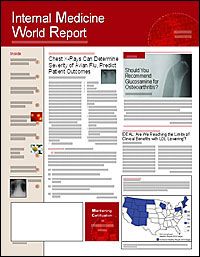Publication
Article
Internal Medicine World Report
Feverfew Extract Decreases Migraine Frequency
Author(s):
An extract of feverfew has been shown to significantly decrease the frequency of migraine head?aches, according to data published in Cephalalgia (2005;25: 1031-1041).
The therapeutic efficacy of feverfew has long been known, and interest in the use of the herb for the treatment of migraine has recently increased. Pow?dered feverfew and ethanolic feverfew extracts have been used successfully in patients with migraine, but such compounds have proved unstable and difficult to standardize.
An extract of feverfew prepared by using supercritical carbon dioxide (MIG-99) was recently developed by investigators in Germany. The extract is enriched with parthenolide, a major sesquiterpene lactone of feverfew with known anti-inflammatory properties, and has been shown to be highly stable with consistent pharmacologic properties.
In this new study by Hans-Christoph Diener, MD, of the University Essen, and colleagues, 170 patients with a diagnosis of migraine, assessed by the International Headache Society criteria, were ran?domized to receive 6.25 mg MIG-99 or placebo 3 times daily for 16 weeks.
All patients had 3 to 6 migraine at?tacks per month within the 3 months before study entry.
The primary study end point was the total number of mi?graine attacks within 28 days during the second and third 28-day treatment periods compared with baseline. Secondary end points included changes in migraine intensity, mean duration of single attacks, total duration of migraine attacks, and the number of days with migraine.
The mean frequency of migraine attacks per month decreased from 4.8 at baseline to 2.9 in the MIG-99 group and 3.5 in the placebo group (P = .0456). The proportion of patients who achieved a >50% decrease in migraine attacks per month was 30.3% in the MIG-99 group and 17.3% in the placebo group (P = .047).
The number of mi?graine days for every 28 days decreased from 7.04 to 4.53 in the MIG-99 group and to 5.60 inthe placebo group. The ?difference in favor of MIG-99 was significant (P = .0353).
The total duration of migraine attacks decreased in both groups, but the difference was not statistically significant. However, the global assessment of efficacy showed significant differences in favor of MIG-99 in patients' and investigators' global assessments (P = .024 and P = .035, respectively).
The rates and types of adverse events were similar in the MIG-99 group (8.4%) and the placebo group (10.2%). The most common adverse events were gastrointestinal complaints, psychiatric disturbances, musculoskeletal disorders, and central and peripheral nervous system disorders. The specific modes of action of feverfew and most other agents used for migraine prophylaxis are not known, ?Dr Diener said.
"Feverfew inhibits the production of prostaglandins, interferes with both ?contractile and relaxant mechanisms in blood vessels, and inhibits the secretion of serotonin from blood platelets," Dr Diener told IMWR. "These effects may explain the migraine prophylactic ?properties of feverfew."
Patients with frequent migraine headaches who desire prophylactic treatment and prefer to avoid the adverse effects of beta-blockers, amitriptyline, topiramate (Topamax), and other drugs frequently used for migraine prophylaxis may be suitable candidates for preventive therapy with feverfew, Dr Diener said. "The ?un?resolved question is whether all feverfew preparations are equally ?effective," he added.






